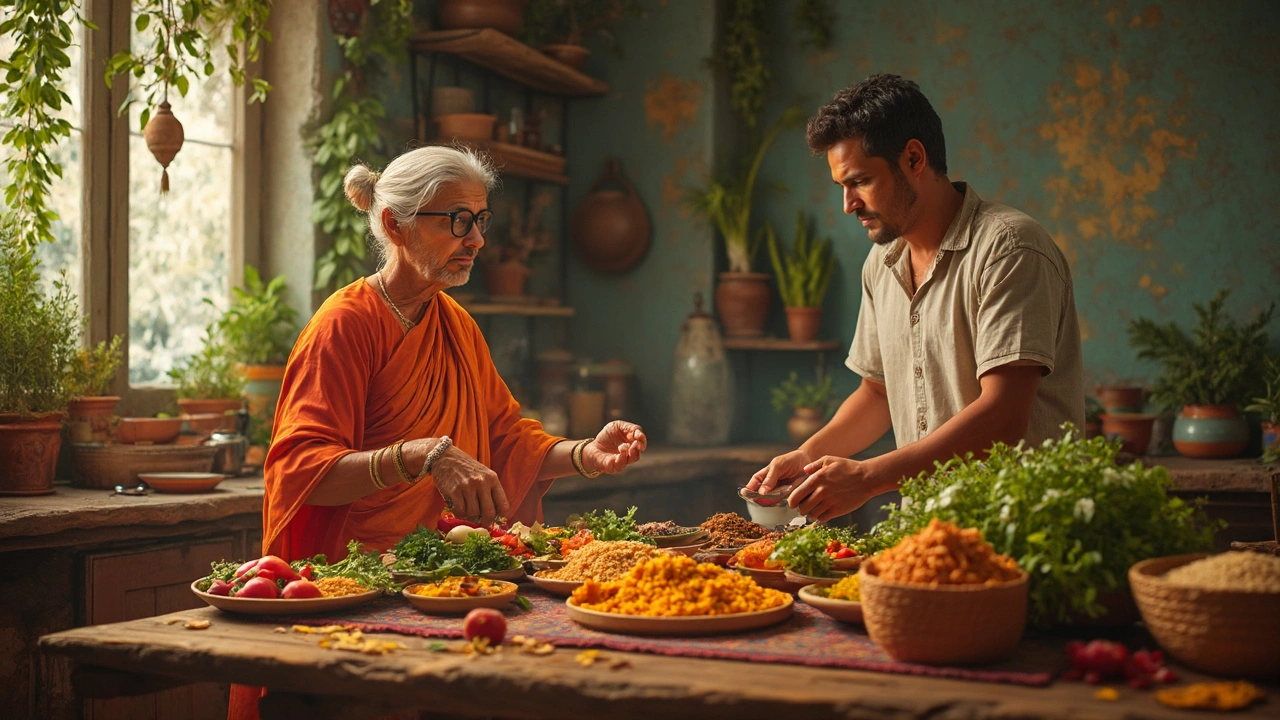Ever feel like eating healthy is one big guessing game? Ayurveda takes a really different approach. Instead of one-size-fits-all meal plans or calorie counting, an Ayurvedic diet asks: what actually works for your body? It’s thousands of years old but way more personal than most modern diets.
This isn’t about trendy superfoods or avoiding carbs. In Ayurveda, how you eat is just as important as what you eat. There are three main body types—called doshas—and figuring out yours can totally change the way you think about food. The idea is to eat in a way that brings your unique system into balance, not just to drop weight or hit some random health target.
Curious if this can make a difference in your daily energy or digestion? Plenty of people say switching to an Ayurvedic way of eating helped them handle cravings and stomach troubles. Even if you’re not ready to give up your favorite comfort foods, learning a bit about Ayurveda might make meals feel less confusing and way more satisfying.
- Ayurveda and Your Body: The Basics
- What’s a Dosha and Why Does It Matter?
- Foods That Fit Each Dosha
- Simple Tips for Starting an Ayurvedic Diet
- Myths, Missteps, and Real-World Advice
Ayurveda and Your Body: The Basics
Ayurveda is really just about working with your body, not against it. What sets it apart from other health systems? It looks at you as a whole person—your sleep, stress, digestion, and daily habits all play into how you feel. The ayurvedic diet is based on this bigger picture.
Here’s something that surprises most people: Ayurveda says there are three main energy types in every person. These are called doshas: Vata, Pitta, and Kapha. Your mix of these doshas shapes everything from your mood swings to your food cravings. Figuring out your main dosha is usually the first step if you want to try this kind of eating.
Let’s break it down. Vata is linked with movement and air, and when it’s high, you might feel restless or cold. Pitta is connected to heat and digestion, and too much can mean you overheat easily or get irritable. Kapha is more about stability and water—think steady energy, but also sometimes sluggishness or extra weight.
The ayurvedic diet isn’t about cutting out entire food groups. Instead, it helps you choose meals that work with your dosha’s needs. Say you’re mostly Kapha—Ayurveda might steer you toward lighter, spicier foods instead of heavy, greasy ones. Or if you’re Vata, warming, oily foods often help you feel grounded.
Still skeptical? In India, Ayurveda is recognized by the government and integrated into hospitals, especially for chronic digestion problems and stress-related issues. A 2023 government report even showed that about 77% of people who tried Ayurveda for stomach issues found some relief.
If you want a quick idea of what this might look like day-to-day, here’s a basic rundown:
- Eat fresh, seasonal foods whenever possible—no microwave meals.
- Spices aren’t just for taste. In Ayurveda, common kitchen spices like cumin, turmeric, and ginger are used to balance digestion.
- How you eat matters. Small, regular meals, eaten in a calm space, tend to work better in this system than rushed, random snacks.
The ayurvedic diet connects food choices with how you actually feel, so it’s not just about following a set plan. The more you pay attention to your body’s daily shifts, the easier it gets to start eating the Ayurvedic way.
What’s a Dosha and Why Does It Matter?
So, when you hear about an ayurvedic diet, you’ll notice the word “dosha” comes up a lot. What’s a dosha? Basically, it’s a type of energy or blueprint that makes up your body and mind. In Ayurveda, there are three main doshas: Vata, Pitta, and Kapha. Most people have one or two that are strongest in them, and figuring out your mix is step one toward eating the Ayurvedic way.
Quick breakdown:
- Vata: This dosha is linked to air and space. People with a lot of Vata tend to be thin, energetic, and get cold easily. Their digestion can be unpredictable.
- Pitta: Related to fire and water. Pittas are usually of medium build, intense, quick to get hot (physically or emotionally), and have strong appetites.
- Kapha: Connected with earth and water. Kapha types are sturdy, calm, slower, and often struggle with sluggishness or weight gain.
Why does knowing your dosha matter? Ayurveda says your dosha tells you which foods help you feel balanced and which ones throw you off. For example, Vata types might love light salads, but those won’t keep them grounded or warm for long. Kaphas might feel awesome after spicy, light meals, but heavy carbs just make them tired.
There’s even some interesting data showing that when people match their meals to their dosha, they’re more likely to stick with healthy habits and feel steady energy all day. Here’s a quick chart so you can get a sense of how doshas differ:
| Dosha | Main Elements | Common Traits | Usual Issues |
|---|---|---|---|
| Vata | Air & Space | Thin, energetic, talkative | Anxiety, dry skin, constipation |
| Pitta | Fire & Water | Medium build, driven, focused | Heartburn, irritability, acne |
| Kapha | Earth & Water | Sturdy, calm, relaxed | Sluggishness, weight gain, congestion |
Personal tip: if you’re not sure about your dosha, online quizzes can give you a starting point. Just pay attention to how your body feels after meals—Ayurveda is all about tuning in and making tweaks based on real results, not just theory.

Foods That Fit Each Dosha
The core of a ayurvedic diet is matching your meals to your dosha. In Ayurveda, your dosha is like your body’s blueprint—Vata, Pitta, or Kapha. Each one has certain traits and needs, so the foods that help you feel your best are different from what works for your friend or partner.
Here’s a breakdown of what usually works for each dosha:
- Vata: If you’re Vata, you might notice you get cold easily, have dry skin, or feel restless. Warm, moist, and grounding foods help keep Vata types balanced. Think stews, soups, cooked grains like rice and oats, sweet potatoes, bananas, avocados, warm milk, and plenty of healthy fats like ghee and olive oil. Skip raw salads and dry snacks—they can make things feel even more out of whack.
- Pitta: Pitta is fiery—think strong digestion, a tendency to get hot, or a quick temper. Cooling, hydrating, and slightly sweet foods calm things down. Best bets? Watermelon, cucumbers, leafy greens, dairy, coconut, and plenty of fresh herbs. Go easy on spicy food, tomatoes, fried food, and alcohol—those can throw Pitta off fast.
- Kapha: Kapha types can get sluggish or gain weight quickly. Light, dry, and spicy foods help wake things up. Go for apples, berries, beans, leafy greens, peppers, ginger, and even a kick of chili. Try to avoid heavy, oily, or super sweet foods like cheese, ice cream, or fried stuff—they can leave you feeling weighed down.
Check out how some typical foods stack up for each dosha:
| Food Item | Best For Vata | Best For Pitta | Best For Kapha |
|---|---|---|---|
| Oatmeal | Yes | In moderation | No |
| Spicy Chili | No | No | Yes |
| Cucumber | Sometimes (if not cold) | Yes | Yes |
| Avocado | Yes | Yes | Limit |
| Cheese | Sometimes | Limit | No |
Meals don’t need to be complicated. Ayurveda is about making small swaps that help your body find balance. The trick is listening to your body. If you’re a Vata but love salad, just try adding something warm or oily—like cooked lentils or a drizzle of olive oil—to balance things out. The ayurvedic diet makes it less about willpower and more about eating to feel good every day.
Simple Tips for Starting an Ayurvedic Diet
So, you want to try an ayurvedic diet? Here’s what actually helps when you’re starting out. Don’t panic—there’s no need to hunt down rare ingredients or toss your whole kitchen. Ayurveda is about simple, doable changes that fit your real life.
First, get curious about your dosha (your body type: Vata, Pitta, or Kapha). There are tons of free online quizzes that give you a rough idea. Many people are a mix, so don’t get stuck perfecting the label. What matters is paying attention to how food makes you feel.
- Eat fresh and seasonal. Anything just-cooked or straight from the market is best. Ayurveda skips canned, frozen, or overprocessed stuff—because your body digests real food more easily.
- Warm, simple meals win. Most ayurvedic guides say warm, cooked meals are easier on your gut than raw salads all the time. Soups, steamed veggies, and lentil stews are super popular.
- Space out your meals. Ayurveda isn’t into constant snacking. Three meals a day, each 4-6 hours apart, is the usual advice. It gives your digestion a break.
- Spices aren’t just flavor. Using things like ginger, cumin, and turmeric can help your body process food. Different doshas vibe with different spices—Pitta types, for example, do better with cooling herbs like cilantro and mint.
- Mind how you eat. Sit down. Don’t scroll your phone. Chew slowly. Believe it or not, Ayurveda says your mood while eating changes how you digest.
Got special leftovers or can’t quit coffee cold-turkey? It’s fine! Ayurveda says stress isn’t good for digestion, so swap habits slowly. Want to see a few numbers? Check out this breakdown of what most people eat when starting on an ayurvedic diet:
| Food | % of Starters Who Choose This |
|---|---|
| Cooked grains (like rice or oatmeal) | 72% |
| Cooked veggies | 65% |
| Fresh fruits | 58% |
| Herbal teas | 54% |
| Meat/eggs (moderate amounts, if eaten) | 27% |
One more thing: take notes for a week on what makes you feel good and what doesn’t. Adjust along the way. That’s the best hack in Ayurveda—there’s no official score, it’s about listening to your own body.

Myths, Missteps, and Real-World Advice
The ayurvedic diet sounds mystical, so it’s easy for rumors and false ideas to pop up. Let’s clear the air.
First, some people think you have to eat only Indian food if you follow Ayurveda. Not true—it’s about balance, not geography. You can use local veggies, grains, and even the occasional burger if it fits your dosha and you eat it mindfully. Also, there’s no such thing as “one magic spice” that fixes everything. Sure, turmeric and ginger get a lot of hype, but Ayurveda is about your whole routine—the timing of meals, combinations of food, even your mood while eating.
One common mistake is thinking there's a perfect “ayurvedic meal plan” online. Every dosha (and person) is different, so copying someone else's plate doesn’t always make you feel your best. Here’s another one: people skip out on entire food groups thinking it will make them super healthy. Ayurveda usually pushes variety and real, whole foods—not restriction.
A lot of folks try to overhaul everything overnight. If you’re just starting out, that’s a recipe for giving up fast. Make small changes at first:
- Notice how different meals make you feel—energized, tired, bloated?
- Try eating your biggest meal at lunch, when digestion is strongest.
- Add spices like cumin, ginger, or coriander—they’re easy ways to aid digestion.
- Avoid eating super late or skipping meals, which throws off your balance.
Worried Ayurveda is just “woo,” not science? Actually, some practices overlap with what nutritionists recommend now, like eating seasonally, getting plenty of fiber, and noticing how stress affects your gut. In one study from 2022, people who followed an ayurvedic diet reported a 20% drop in bloating and indigestion compared to their old eating habits.
| Common Myth | Reality |
|---|---|
| You have to give up all comfort foods | You can adjust most meals with simple tweaks, not full replacements |
| Only vegetarian is allowed | Meat can fit in, depending on your region, traditions, and dosha |
| All herbs and oils are safe for everyone | Some can mess with meds or allergies, so always check first |
Shortcut: don’t get caught up in “rules.” Ayurveda gives you a structure, not jail time. Use it like GPS—helpful, but you still decide where to stop.





